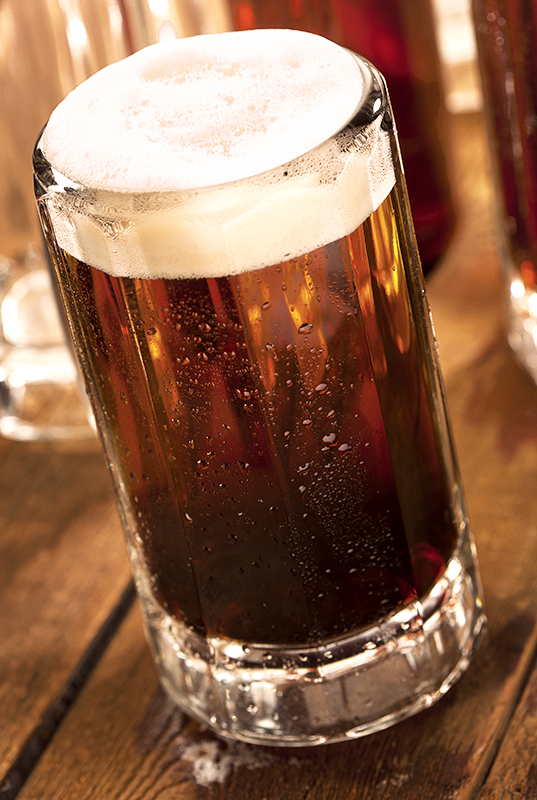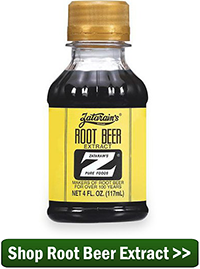 If you grew up in the US, chances are you have fond memories of A&W and Barq’s – there’s just nothing like the woody, spicy taste of root beer.
If you grew up in the US, chances are you have fond memories of A&W and Barq’s – there’s just nothing like the woody, spicy taste of root beer.
Think of the name “root” beer – traditionally it is actually made with a variety of roots, herbs, and spices that contribute flavor and color to the concoction. Among the common ones are wintergreen, vanilla, ginger, licorice, anise, birch, burdock, and sarsaparilla, to name a few.
When making your own root beer, trial and error will help you figure out what methods and ingredients you like best.
How to Make Homemade Root Beer
This version of root beer is a soda. Due to the fact that the root beer is bottle conditioned, there’s a small amount (less than 0.5% ABV) of alcohol present in the beer, but not enough to get much of a buzz.
The flavoring in this root beer recipe comes from Zatarain’s Root Beer Extract and makes the brewing process very simple. The most important thing is to halt the fermentation when the carbonation is correct by refrigerating the root beer. Otherwise, bottles could explode.
Feel free to scale this root beer recipe for a larger or smaller batch.
Zatarain’s Root Beer Recipe
(5-gallon batch)
Ingredients
1, four-ounce bottle Root Beer Extract
5 gallons of warm, filtered water
3-4 lbs. sugar
5 grams dried beer yeast dissolved in warm water
Directions
Fill a bottling bucket with five gallons of warm (not hot), filtered water. Dissolve sugar in water, then add root beer extract and hydrated beer yeast. Mix well, then bottle in about 53 cleaned and sanitized 12-oz. beer bottles. Cap securely and age bottles at room temperature for 24 hours. Open a bottle and check for appropriate carbonation. If more time is needed, check again every 8-12 hours until desired carbonation is achieved. When desired carbonation is reached, store bottles in a refrigerator to prevent further fermentation.
How to Make Alcoholic Root Beer
For those who want to make a “grown-up” or more traditional version of root beer, the technique gets a little more interesting. Instead of a root beer extract, this recipe uses a mix of herbs and spices to achieve the right blend of flavors. Many of them can be found at natural or health food stores in the bulk section. And instead of large amounts of sugar remaining in the root beer, we’ll use malt extract and brew like we would a normal beer. Just keep in mind that because we’re allowing the beer to ferment, hard root beer won’t taste as sweet as what you buy from the store. However, lactose sugar, caramel malt, and Carapils malt help keep the residual sweetness on the higher end.
“Hard” Root Beer Recipe
(5-gallon batch, partial mash)
Specs
OG: 1.068
FG: 1.023
ABV: 5.9%
SRM: 28
Ingredients
6.6 lbs. dark LME
1 lb. dark DME
1 lb. caramel 90 malt
1 lb. Carapils malt
1 lb. lactose sugar
4 oz. dried sarsaparilla root
2 oz. dried burdock root
2 oz. dried spikenard root
1 oz. dried wintergreen leaves
1 oz. vanilla extract
0.5 oz. dried licorice root
1 oz. hops (any variety)
1 pack ale yeast
Directions
Steep crushed grains in one gallon of water at 155˚F for one hour. Strain out from wort, then mix in malt extract and enough water to make 2.5 to 5 gallons of wort, depending on the size of your brew kettle. Add herbs, spices, and hops and boil for 30 minutes. Strain out herbs and spices and mix in lactose sugar. If needed, top off with enough clean, filtered water to make five gallons. Cool and transfer to a clean, sanitized fermenter and ferment until complete. Bottle or keg as you would otherwise.
That’s how you make your own root beer. As you can see either of these recipes are not all that difficult, and the first recipe would be great to do with the kids.
—–
David Ackley is a beer writer, homebrewer, and self-described “craft beer crusader.” He holds a General Certificate in Brewing from the Institute of Brewing and Distilling and is founder of the Local Beer Blog.

I might be a little late to the party on this one but I’m hoping I could get a few more pointers. How long should you let the hard root beer ferment for? And just to be clear, I don’t need to add any priming sugar to carbonate? Thanks so much for any help you guys can give me.
Mark, how long it may take can vary. What you need to do is keep track with a hydrometer. The ending specific gravity reading will be about 1.023. If you plan to carbonate you will need priming sugar.
I’m wondering if you have any tips on converting the alcoholic version to an all grain recipe. I’m really excited to try it either way, but I prefer to work with grains.
Beth, this may vary from one brewer to the next based on how effective or efficient your mashing techniques are. The conversion is to use 10.5 pounds of Briess 2 Row Brewer’s Malt in place of the extract and the dry malt.
2 Row Malt
http://www.eckraus.com/2-row-brewers-malt-briess-1.html
Thank you so much for the quick reply! I can’t wait to try this!
Will sugar need to be added when bottling since there is already sugar in the recipe? If so how much for a five gallon recipe? I don’t want to have bottle bombs.
Matt, you do not need to add any additional sugar to the recipe. Just like with beer, the yeast and sugar combination will make the carbonation of the Root Beer. You do want to make sure that you bottle the Root Beer in beer bottles with caps or plastic bottles and caps that are made to withstand the pressure. Below is the link to all of the bottles that we have that are acceptable to use for bottling soda pop.
Soda Pop
http://www.eckraus.com/soda-pop-making-recipes-ingredients?limit=all
I’m going to try, a trick made by accident. One batch of beer I forgot to put my hops in my mash. Oups, to much Charlie Papazian relaxing. Next weekend realizing my hops inventory was too much. I boiled 1.5 gallons of water and added some honey with no yeast, and let it cool down to 75 degrees, used a filter funnel with cheese cloth on it and dumped it into my carbod, and shook the sh$% out of it to mix it. Stired all the bottom stuff up, and everything blended.Re-activating the yeast. let it bubble in a cool garage with a p-trap hose into a bottle of liquid because it was rely perking, When everything settled and still some perkulating, I racked it and put the normal air trap on. Perked for three days the I soda kegged it . Co2 does make every glass have a head. Taste on this batch is the best in my life, from a screw up on my part. I don’t see why doing a second augmentation of flavors in adding root beer flavor after primary fermentation, with added sugar like honey then capping it off. Honey can be strong if too much is added, but if it is aged alcohol content goes up and it mellows out.
How long can the root beer be stored? How long does it need to be refrigerated? I would like to store it on the shelf at some point, is this possible or am I only to keep it in the fridge until consumption time?
Tayna, actually, after you have carbonated it you will need to store the root beer in the refrigerator until it is all consumed. The reason for this is to keep the carbonation pressure from building up to more that the bottles can withstand and risking the bottles exploding.
Just wondering what to do if you want it sweeter? Could you add sugar after the fact? Also on the hard root beer could you use equal amount corn sugar?
Lisa, if you prefer the Root Beer sweeter, then yes you can additional sugar to taste after the carbonation process and refrigerate immediately. Regarding the sugar, if you are asking to substitute the lactose sugar for corn sugar, you want to stay with the lactose sugar. The lactose sugar is non-fermentable sugar that’s purpose is to add body and some sweetness to the hard root beer.
I made a 2 1/2 gal batch half was for the kids so other non alcoholic but the half I left in the fermenter and when it’s done I’m going to add Xylitol sweetener to sweeten it up
How did your fully fermented and backsweetened vversion turn out?
For the Zatarain’s root beer extract does anyone have a recipe for a non-alcoholic in a corny with co2 gas? I’m planning a family Oktoberfest party and would like for my grandkids to have enjoy a kegged root beer.
Instead of bottles could you condition the Zatarain’s Root Beer Recipe in a Korny keg?
Yes,you can carbonate your soda pop with a draft system.
On the alcohol version, what kind of bottles are people using? Will regular glass bottles I use for conditioning homebrew beer in work or will they explode?
My grandmother was a Zatarain, and the family drank their own root beer. My mother remembered from her childhood, staying at her grandmother’s in the country in the summers and sometimes being wakened by the explosion of a bottle of root beer in the basement. This is Louisiana we’re talking, and summer nights could be very warm; they all slept out on the verandahs, which surrounded the Victorian house. I thought it was a colorful story, but i never doubted that there was a basis for it in fact.